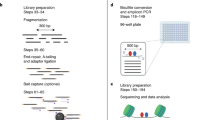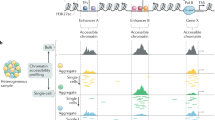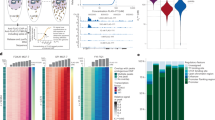Abstract
High-throughput sequencing technologies have allowed many gene locus–level molecular biology assays to become genome-wide profiling methods. DNA-cleaving enzymes such as DNase I have been used to probe accessible chromatin. The accessible regions contain functional regulatory sites, including promoters, insulators and enhancers. Deep sequencing of DNase-seq libraries and computational analysis of the cut profiles have been used to infer protein occupancy in the genome at the nucleotide level, a method introduced as 'digital genomic footprinting'. The approach has been proposed as an attractive alternative to the analysis of transcription factors (TFs) by chromatin immunoprecipitation followed by sequencing (ChIP-seq), and in theory it should overcome antibody issues, poor resolution and batch effects. Recent reports point to limitations of the DNase-based genomic footprinting approach and call into question the scope of detectable protein occupancy, especially for TFs with short-lived chromatin binding. The genomics community is grappling with issues concerning the utility of genomic footprinting and is reassessing the proposed approaches in terms of robust deliverables. Here we summarize the consensus as well as different views emerging from recent reports, and we describe the remaining issues and hurdles for genomic footprinting.
This is a preview of subscription content, access via your institution
Access options
Subscribe to this journal
Receive 12 print issues and online access
$259.00 per year
only $21.58 per issue
Buy this article
- Purchase on Springer Link
- Instant access to full article PDF
Prices may be subject to local taxes which are calculated during checkout




Similar content being viewed by others
References
Tullius, T.D. Physical studies of protein-DNA complexes by footprinting. Annu. Rev. Biophys. Biophys. Chem. 18, 213–237 (1989).
Church, G.M., Ephrussi, A., Gilbert, W. & Tonegawa, S. Cell-type-specific contacts to immunoglobulin enhancers in nuclei. Nature 313, 798–801 (1985).
Jackson, P.D. & Felsenfeld, G. A method for mapping intranuclear protein-DNA interactions and its application to a nuclease hypersensitive site. Proc. Natl. Acad. Sci. USA 82, 2296–2300 (1985).
Hesselberth, J.R. et al. Global mapping of protein-DNA interactions in vivo by digital genomic footprinting. Nat. Methods 6, 283–289 (2009).
Thurman, R.E. et al. The accessible chromatin landscape of the human genome. Nature 489, 75–82 (2012).
Baek, S., Sung, M.H. & Hager, G.L. Quantitative analysis of genome-wide chromatin remodeling. Methods Mol. Biol. 833, 433–441 (2012).
Morris, S.A. et al. Overlapping chromatin remodeling systems collaborate genome-wide at dynamic chromatin transitions. Nat. Struct. Mol. Biol. 21, 73–81 (2014).
John, S. et al. Chromatin accessibility pre-determines glucocorticoid receptor binding patterns. Nat. Genet. 43, 264–268 (2011).
Sung, M.H., Guertin, M.J., Baek, S. & Hager, G.L. DNase footprint signatures are dictated by factor dynamics and DNA sequence. Mol. Cell 56, 275–285 (2014).
He, H.H. et al. Refined DNase-seq protocol and data analysis reveals intrinsic bias in transcription factor footprint identification. Nat. Methods 11, 73–78 (2014).
Pique-Regi, R. et al. Accurate inference of transcription factor binding from DNA sequence and chromatin accessibility data. Genome Res. 21, 447–455 (2011).
Neph, S. et al. An expansive human regulatory lexicon encoded in transcription factor footprints. Nature 489, 83–90 (2012).
Mercer, T.R. et al. The human mitochondrial transcriptome. Cell 146, 645–658 (2011).
Boyle, A.P. et al. High-resolution genome-wide in vivo footprinting of diverse transcription factors in human cells. Genome Res. 21, 456–464 (2011).
Cuellar-Partida, G. et al. Epigenetic priors for identifying active transcription factor binding sites. Bioinformatics 28, 56–62 (2012).
Luo, K. & Hartemink, A.J. Using DNase digestion data to accurately identify transcription factor binding sites. Pac. Symp. Biocomput. 2013, 80–91 (2013).
Gusmao, E.G., Dieterich, C., Zenke, M. & Costa, I.G. Detection of active transcription factor binding sites with the combination of DNase hypersensitivity and histone modifications. Bioinformatics 30, 3143–3151 (2014).
Sherwood, R.I. et al. Discovery of directional and nondirectional pioneer transcription factors by modeling DNase profile magnitude and shape. Nat. Biotechnol. 32, 171–178 (2014).
Piper, J. et al. Wellington: a novel method for the accurate identification of digital genomic footprints from DNase-seq data. Nucleic Acids Res. 41, e201 (2013).
Lazarovici, A. et al. Probing DNA shape and methylation state on a genomic scale with DNase I. Proc. Natl. Acad. Sci. USA 110, 6376–6381 (2013).
Yardimci, G.G., Frank, C.L., Crawford, G.E. & Ohler, U. Explicit DNase sequence bias modeling enables high-resolution transcription factor footprint detection. Nucleic Acids Res. 42, 11865–11878 (2014).
Grøntved, L. et al. Rapid genome-scale mapping of chromatin accessibility in tissue. Epigenetics Chromatin 5, 10 (2012).
Nakahashi, H. et al. A genome-wide map of CTCF multivalency redefines the CTCF code. Cell Rep. 3, 1678–1689 (2013).
Poorey, K. et al. Measuring chromatin interaction dynamics on the second time scale at single-copy genes. Science 342, 369–372 (2013).
Buenrostro, J.D. et al. Single-cell chromatin accessibility reveals principles of regulatory variation. Nature 523, 486–490 (2015).
Cusanovich, D.A. et al. Multiplex single-cell profiling of chromatin accessibility by combinatorial cellular indexing. Science 348, 910–914 (2015).
Voss, T.C. & Hager, G.L. Dynamic regulation of transcriptional states by chromatin and transcription factors. Nat. Rev. Genet. 15, 69–81 (2014).
Sung, M.H. & McNally, J.G. Live cell imaging and systems biology. Wiley Interdiscip. Rev. Syst. Biol. Med. 3, 167–182 (2011).
Hager, G.L., McNally, J.G. & Misteli, T. Transcription dynamics. Mol. Cell 35, 741–753 (2009).
Voss, T.C. et al. Dynamic exchange at regulatory elements during chromatin remodeling underlies assisted loading mechanism. Cell 146, 544–554 (2011).
Morisaki, T., Muller, W.G., Golob, N., Mazza, D. & McNally, J.G. Single-molecule analysis of transcription factor binding at transcription sites in live cells. Nat. Commun. 5, 4456 (2014).
van Royen, M.E. et al. Androgen receptor complexes probe DNA for recognition sequences by short random interactions. J. Cell Sci. 127, 1406–1416 (2014).
Groeneweg, F.L. et al. Quantitation of glucocorticoid receptor DNA-binding dynamics by single-molecule microscopy and FRAP. PLoS ONE 9, e90532 (2014).
Gebhardt, J.C. et al. Single-molecule imaging of transcription factor binding to DNA in live mammalian cells. Nat. Methods 10, 421–426 (2013).
Crocker, J. et al. Low affinity binding site clusters confer Hox specificity and regulatory robustness. Cell 160, 191–203 (2015).
Chen, J. et al. Single-molecule dynamics of enhanceosome assembly in embryonic stem cells. Cell 156, 1274–1285 (2014).
Sharp, Z.D. et al. Estrogen-receptor-alpha exchange and chromatin dynamics are ligand- and domain-dependent. J. Cell Sci. 119, 4101–4116 (2006).
Bosisio, D. et al. A hyper-dynamic equilibrium between promoter-bound and nucleoplasmic dimers controls NF-kB-dependent gene activity. EMBO J. 25, 798–810 (2006).
McNally, J.G., Mueller, W.G., Walker, D., Wolford, R.G. & Hager, G.L. The glucocorticoid receptor: rapid exchange with regulatory sites in living cells. Science 287, 1262–1265 (2000).
Stergachis, A.B. et al. Conservation of trans-acting circuitry during mammalian regulatory evolution. Nature 515, 365–370 (2014).
Neph, S. et al. Circuitry and dynamics of human transcription factor regulatory networks. Cell 150, 1274–1286 (2012).
Badis, G. et al. Diversity and complexity in DNA recognition by transcription factors. Science 324, 1720–1723 (2009).
Jolma, A. et al. DNA-binding specificities of human transcription factors. Cell 152, 327–339 (2013).
Weirauch, M.T. et al. Evaluation of methods for modeling transcription factor sequence specificity. Nat. Biotechnol. 31, 126–134 (2013).
Buenrostro, J.D., Giresi, P.G., Zaba, L.C., Chang, H.Y. & Greenleaf, W.J. Transposition of native chromatin for fast and sensitive epigenomic profiling of open chromatin, DNA-binding proteins and nucleosome position. Nat. Methods 10, 1213–1218 (2013).
Gerstein, M.B. et al. Architecture of the human regulatory network derived from ENCODE data. Nature 489, 91–100 (2012).
Bailey, T.L. et al. MEME SUITE: tools for motif discovery and searching. Nucleic Acids Res. 37, W202–W208 (2009).
Grant, C.E., Bailey, T.L. & Noble, W.S. FIMO: scanning for occurrences of a given motif. Bioinformatics 27, 1017–1018 (2011).
Biddie, S.C. et al. Transcription factor AP1 potentiates chromatin accessibility and glucocorticoid receptor binding. Mol. Cell 43, 145–155 (2011).
Lickwar, C.R., Mueller, F., Hanlon, S.E., McNally, J.G. & Lieb, J.D. Genome-wide protein-DNA binding dynamics suggest a molecular clutch for transcription factor function. Nature 484, 251–255 (2012).
Malnou, C.E. et al. Heterodimerization with different Jun proteins controls c-Fos intranuclear dynamics and distribution. J. Biol. Chem. 285, 6552–6562 (2010).
Mayr, B.M., Guzman, E. & Montminy, M. Glutamine rich and basic region/leucine zipper (bZIP) domains stabilize cAMP-response element-binding protein (CREB) binding to chromatin. J. Biol. Chem. 280, 15103–15110 (2005).
Guertin, M.J., Zhang, X., Coonrod, S.A. & Hager, G.L. Transient ER binding and p300 redistribution support a squelching mechanism for E2-repressed genes. Mol. Endocrinol. 28, 1522–1533 (2014).
Grøntved, L. et al. Transcriptional activation by the thyroid hormone receptor through ligand dependent receptor recruitment and chromatin remodeling. Nat. Commun. 6, 7048 (2015).
Marcelli, M. et al. Quantifying effects of ligands on androgen receptor nuclear translocation, intranuclear dynamics, and solubility. J. Cell. Biochem. 98, 770–788 (2006).
Yu, J. et al. An integrated network of androgen receptor, polycomb, and TMPRSS2-ERG gene fusions in prostate cancer progression. Cancer Cell 17, 443–454 (2010).
Tirard, M., Almeida, O.F., Hutzler, P., Melchior, F. & Michaelidis, T.M. Sumoylation and proteasomal activity determine the transactivation properties of the mineralocorticoid receptor. Mol. Cell. Endocrinol. 268, 20–29 (2007).
Le Billan, F. et al. Cistrome of the aldosterone-activated mineralocorticoid receptor in human renal cells. FASEB J. 29, 3977–3989 (2015).
Acknowledgements
Computationally intensive tasks were performed using the US National Institutes of Health (NIH) Biowulf cluster, a GNU-Linux parallel processing system. We thank the NIH Helix systems staff for the management of this system. This work was supported by the Intramural Research Program of the NIH, National Cancer Institute.
Author information
Authors and Affiliations
Contributions
M.-H.S. and G.L.H. conceived the project. S.B. and M.-H.S. performed the analysis. M.-H.S. and G.L.H. wrote the manuscript.
Corresponding authors
Ethics declarations
Competing interests
The authors declare no competing financial interests.
Rights and permissions
About this article
Cite this article
Sung, MH., Baek, S. & Hager, G. Genome-wide footprinting: ready for prime time?. Nat Methods 13, 222–228 (2016). https://doi.org/10.1038/nmeth.3766
Received:
Accepted:
Published:
Issue Date:
DOI: https://doi.org/10.1038/nmeth.3766
This article is cited by
-
CRISPR/Cas9 and FLP-FRT mediated regulatory dissection of the BX-C of Drosophila melanogaster
Chromosome Research (2023)
-
Enhancer selection dictates gene expression responses in remote organs during tissue regeneration
Nature Cell Biology (2022)
-
Chromatin occupancy and target genes of the haematopoietic master transcription factor MYB
Scientific Reports (2021)
-
ATAC-seq footprinting unravels kinetics of transcription factor binding during zygotic genome activation
Nature Communications (2020)
-
XL-DNase-seq: improved footprinting of dynamic transcription factors
Epigenetics & Chromatin (2019)



